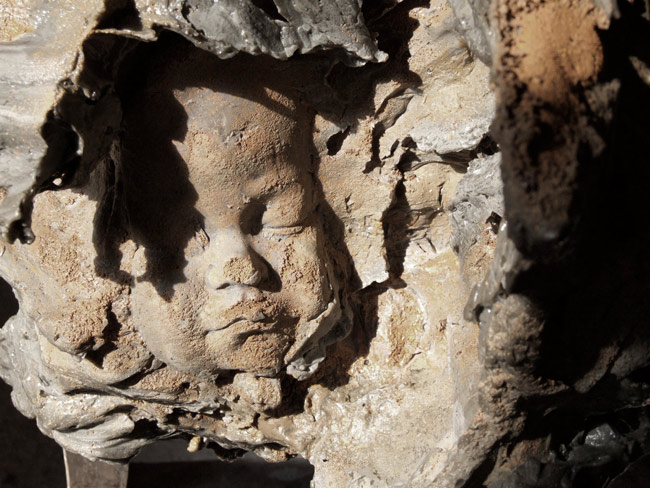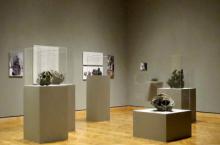
“When you read Ellen’s biography, you might feel the pain, loss and helplessness that led her to compromise on her dignity, and trade her rebellious spirit for acceptance and cooperation. However, as I immersed myself in the process of writing her story, allowing myself to become her, I was surprised and touched to witness the transformation of her grim circumstances into a courageous and liberating artistic practice that revealed a deeper story.” - Iris Häeussler
(text continues after gallery...)
Häeussler’s conceptual portrait of Ellen Stanley, a fictitious Chicago woman diagnosed with “hysterical blindness” in 1923, at age 28, is presented through a series of free-form wax sculptures juxtaposed with collected biological details. The five pieces vary in size, the largest shows applications of yellow and tan pigments on the surface, especially along the edges and ridges. While Ellen worked tirelessly to create her sculptures over a six year period, between 1925-1931, most were destroyed by her family so the wax could be reused again and again.The five surviving sculptures on display were ostensibly made during Ellen’s final months of life. Together these artifacts offer a fragile bridge between Ellen’s inner and outer worlds.
Biographical Notes on Ellen Stanley (1895-1931)
Ellen was born in Chicago, the only child of a merchant, Patrick Parnell (1850-1922), and his wife Sarah (1862-1927), née Corkin. Ellen was known to be a bright, but sensitive and frail child. In 1913, she was sent to university where she studied botany, unusual for a young woman during this time, and later found employment as an assistant librarian. In 1919, she married a local pharmacist, Arthur Stanley (1898-1957), who inherited his father's pharmacy following his untimely death from the Spanish Flu. Ellen and Arthur had one child together, Anne, born in 1923.
Shortly after giving birth to Anne, Ellen experienced a severe condition that was diagnosed as "hysterical blindness." In the early 20th century, “hysterical blindness” was considered a symptom of “conversion disorder”–loosely defined by professionals as a “neurotic” or psychological condition that manifested as physical impairment. Hysterical symptoms were predominantly attributed to women, treated as a mental disorder, and historically thought to be triggered by sexual repression or trauma. Whether Ellen’s blindness was indeed “hysterical,” as her doctors claimed, or whether there was some other physiological cause, such as a stroke she may have suffered as a complication of protracted labour, remains a question to this day. Whatever the true cause of Ellen’s symptoms, two determinative events followed: she would eventually become totally blind, and, as a result of being diagnosed with a neurotic disorder, she was stigmatized and dehumanized as a “mental patient”.
Ellen’s doctors recommended that she be admitted to the Illinois State Hospital for the Insane, believing that the burden of having to care for a newborn would exacerbate her condition. Arthur complied with the doctors’ recommendation and arranged for Ellen to be admitted to the hospital. A distant cousin, 17 year old Elizabeth, moved into Arthur and Ellen’s house to take care of the child and manage the household during Ellen’s absence. Arthur visited Ellen frequently, but becoming increasingly distressed about his wife’s physical and mental state and the institutional environment in which she was confined. In the summer of 1925, Arthur arranged for Ellen to be discharged from the state hospital and put into his care. By then, Elizabeth had become the center of the family, running the household smoothly and raising Anne as her own.
Ellen's mother visited to help settle her daughter during this challenging time. On this occasion she brought Ellen a curious gift: a cone about the size of a sugarloaf. As a child, Ellen's mother once observed a woman known as “Old Mary” pouring a hot liquid into a hole in the ground. When Old Mary died, she recovered it from the soil. It smelled like beeswax. Ellen's mother was convinced that Old Mary had practiced some form of folk medicine and hoped that the gift would somehow help Ellen.
Over time, Elizabeth and Ellen developed a practice of creating sculptures together. Once a week, Elizabeth would assist Ellen by melting a huge pot of beeswax in the kitchen. The wax was strained through a piece of cloth and then used to fill clay molds that Ellen created in an old bathtub. Laboriously, Ellen would carve probing cavities into the beds of clay with her hands, as if searching for something deep within a void. Ellen would then have Elizabeth assist with pouring molten wax to fill each void.
Once the wax solidified, Ellen would carefully dig the strange forms out of the clay, scrubbing each in a bucket of water to remove the residue of soft clay from the wax surface. She would playfully run her fingers along the ridges and slopes, exploring each mysterious surface as if trying to make sense of them. To provide Ellen with a steady supply of wax, the family would simply break up finished sculptures and remelt the wax to be used over and over.
As Ellen settled into a life at home that revolved around her sculpture making routine, Arthur and Elizabeth began living together as a couple, sharing a bed and table and parenting Anne. In 1929, Elizabeth and Arthur had another child, James. In January 1931, Ellen died of complications from pneumonia. All that remained of Ellen Stanley’s life were her final five sculptures, and the wax cone gifted to Ellen by her mother.






